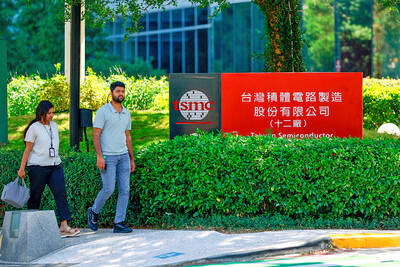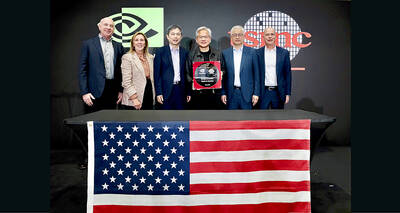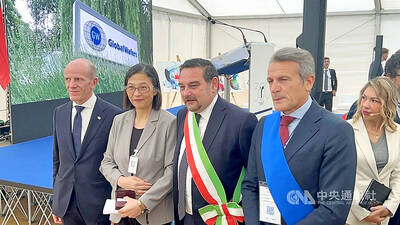The production value of Taiwanese manufacturers hit a new record quarter, reaching NT$4.19 trillion (US$150.47 billion) last quarter, up 29.68 percent, amid steady and growing demand in technology and traditional sectors, Ministry of Economic Affairs (MOEA) data released yesterday said.
“As the global economy rebounds and international commodity prices remain high, Taiwanese manufacturers had a record quarter of sales,” Department of Statistics Deputy Director-General Huang Wei-jie (黃偉傑) said. “This is a record for single-quarter sales and markes four continuous quarters for growth.”
The traditional sector led the growth, with strong downstream demand and high international prices pushing up revenue, the ministry said.
Basic metals grew by 78.91 percent, chemical materials grew by 66.87 percent and petrochemical products grew by 48.92 percent year-on-year. Mechanical equipment rose on demand from semiconductor and 5G demand, with industrial output rising 27.36 percent.
Meanwhile, consumers who had put off car purchases during the a local COVID-19 outbreak poured began to buy, causing the auto and parts market to increase by 15.04 percent year-on-year.
“The pent-up demand has boosted the domestic auto market, in addition to the rise in the US and European auto markets,” Huang said.
The information communication technology sector saw electronic components hit an all-time high last quarter, with production value up 21 percent year-on-year. Semiconductors continue to be in strong demand for 5G, AIoT and automotive applications, growing by 19.71 percent to NT$545.7 billion to another record quarter.
The ministry anticipates continued growth for the current quarter, Huang said.
“We are still under the influence of COVID-19, especially with the uncertainty of new variants and the possibility that the virus could spike again in the winter, and the dual-control policy in China is another source of uncertainty,” Huang said. “However, we expect steady growth for the global economy.”

RECYCLE: Taiwan would aid manufacturers in refining rare earths from discarded appliances, which would fit the nation’s circular economy goals, minister Kung said Taiwan would work with the US and Japan on a proposed cooperation initiative in response to Beijing’s newly announced rare earth export curbs, Minister of Economic Affairs Kung Ming-hsin (龔明鑫) said yesterday. China last week announced new restrictions requiring companies to obtain export licenses if their products contain more than 0.1 percent of Chinese-origin rare earths by value. US Secretary of the Treasury Scott Bessent on Wednesday responded by saying that Beijing was “unreliable” in its rare earths exports, adding that the US would “neither be commanded, nor controlled” by China, several media outlets reported. Japanese Minister of Finance Katsunobu Kato yesterday also

‘DRAMATIC AND POSITIVE’: AI growth would be better than it previously forecast and would stay robust even if the Chinese market became inaccessible for customers, it said Taiwan Semiconductor Manufacturing Co (TSMC, 台積電) yesterday raised its full-year revenue growth outlook after posting record profit for last quarter, despite growing market concern about an artificial intelligence (AI) bubble. The company said it expects revenue to expand about 35 percent year-on-year, driven mainly by faster-than-expected demand for leading-edge chips for AI applications. The world’s biggest contract chipmaker in July projected that revenue this year would expand about 30 percent in US dollar terms. The company also slightly hiked its capital expenditure for this year to US$40 billion to US$42 billion, compared with US$38 billion to US$42 billion it set previously. “AI demand actually

Jensen Huang (黃仁勳), founder and CEO of US-based artificial intelligence chip designer Nvidia Corp and Taiwan Semiconductor Manufacturing Co (TSMC, 台積電) on Friday celebrated the first Nvidia Blackwell wafer produced on US soil. Huang visited TSMC’s advanced wafer fab in the US state of Arizona and joined the Taiwanese chipmaker’s executives to witness the efforts to “build the infrastructure that powers the world’s AI factories, right here in America,” Nvidia said in a statement. At the event, Huang joined Y.L. Wang (王英郎), vice president of operations at TSMC, in signing their names on the Blackwell wafer to

Taiwan-based GlobalWafers Co., the world’s third largest silicon wafer supplier, on Wednesday opened a 12-inch silicon wafer plant in Novara, northern Italy - the country’s most advanced silicon wafer facility to date. The new plant, coded “Fab300,” was launched by GlobalWafers’ Italian subsidiary MEMC Electronics Materials S.p.A at a ceremony attended by Taiwan’s representative to Italy Vincent Tsai (蔡允中), MEMC President Marco Sciamanna and Novara Mayor Alessandro Canelli. GlobalWafers Chairwoman Doris Hsu (徐秀蘭) said the investment marked a milestone in the company’s expansion in Europe, adding that the Novara plant will be powered entirely by renewable energy - a reflection of its